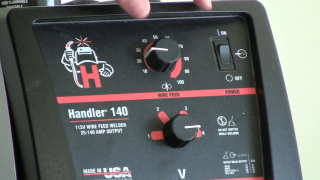Is MIG welding for beginners?
The answer is absolutely YES! Why is it though?
The reason that MIG welding is so damn good for beginners is because there isn’t nearly as high of a learning curve as you would find with stick welding or TIG welding. Learning how to MIG weld is fun and easy.
Example #1
If I was to put a MIG gun in your hand right now and told you to put the wire to the metal and pull the trigger, you would be welding right away. On your first attempt!
Now obviously there are MIG welding techniques you need to know and practice in order to make good solid welds, but there are plenty of MIG welding tips on this website to help you do that.
Example #2:
Now let’s assume I handed you a stick welder and said go ahead and lay a weld bead. You would be standing there for a good while trying to get the welding rod unstuck from the workpiece.
Not only that, you would have to control the arc gap because the welding rod will melt down. Plus, when you use a stick welder it produces slag which makes it difficult to see the weld puddle.
Example #3:
Now let’s say I handed you a TIG welder and said go ahead and lay a weld bead. Since you need 2 hands when using a TIG welder, one to hold the torch and the other for the filler rod, you would be struggling even more.
Plus, when you weld with a TIG welder you control the heat with your foot pedal. That’s another problem thrown into the equation.
Stick and TIG welding are tried and true welding processes, and each one is used for different purposes. They are great welding methods, just not the best for beginners.
When you start out you will first want to learn how to MIG weld steel, but before we go into the MIG welding training, let’s talk about the MIG welding basics.
MIG Welding Basics
To learn MIG welding you need to know a few basics about how a MIG welder works.
Firstly, MIG welding stands for metal inert gas. It uses a shielding gas to protect the weld puddle from atmospheric gases that could weaken the weld.
Just like stick welding uses a flux coating to shield the weld puddle, MIG uses gas.
MIG is also known as wire feed welding because it uses a continuously fed wire as the electrode and filler metal.
You can see in the image above that the wire is coming out of the end of the nozzle. What you’re looking at here is the MIG gun, and it’s got a button that you press to feed the wire.
When you press the button it also releases the MIG welding gas.
There are 2 MIG welding processes
- One uses a gas cylinder that you hook up to your welder
- The other is called flux core MIG welding.
It’s called flux core because it doesn’t use a gas cylinder, but rather a wire that has flux on the inside to protect the weld puddle.
Here’s a shot of the inside of a wire feed welder to show you the mig welding basics of the machine.
You can see the roll of wire that you put into the machine, and the wire is fed into the drive rolls you see to the right. The start turning and feeding the wire out as soon as you press the trigger on the mig gun.
This is where you insert your roll of solid wire if you’re mig welding gas, or your roll of flux core wire if you’re not using gas.
MIG Voltage & Wire Speed

One knob is for the voltage and the other is for the wire speed. These both work in conjunction with one another.
If you turn one up then you turn up the other. There is usually a chart that will tell you where the settings need to be depending on the thickness of metal you’re working on.
The thicker the metal, the higher the voltage and wire speed.
Like I was saying earlier, when you’re not using the flux core MIG welding process, then you will use a cylinder of shielding gas.
If you want to use a gas cylinder then make sure you get a MIG welder that will accept a gas hookup. Not all of them will.
Most MIG welders you buy on the market will come with this ability to use MIG welding gas, so they will also come with a regulator to control the gas pressure.
Always use safety first when you’re dealing with high pressure gas cylinders. If they are handled improperly they can cause a lot of damage to you and your surroundings.
Be sure that when you first get your cylinder from the supplier you crack the valve to blow any dirt or dust out of the attachment.
You don’t want those things getting inside your regulators.

